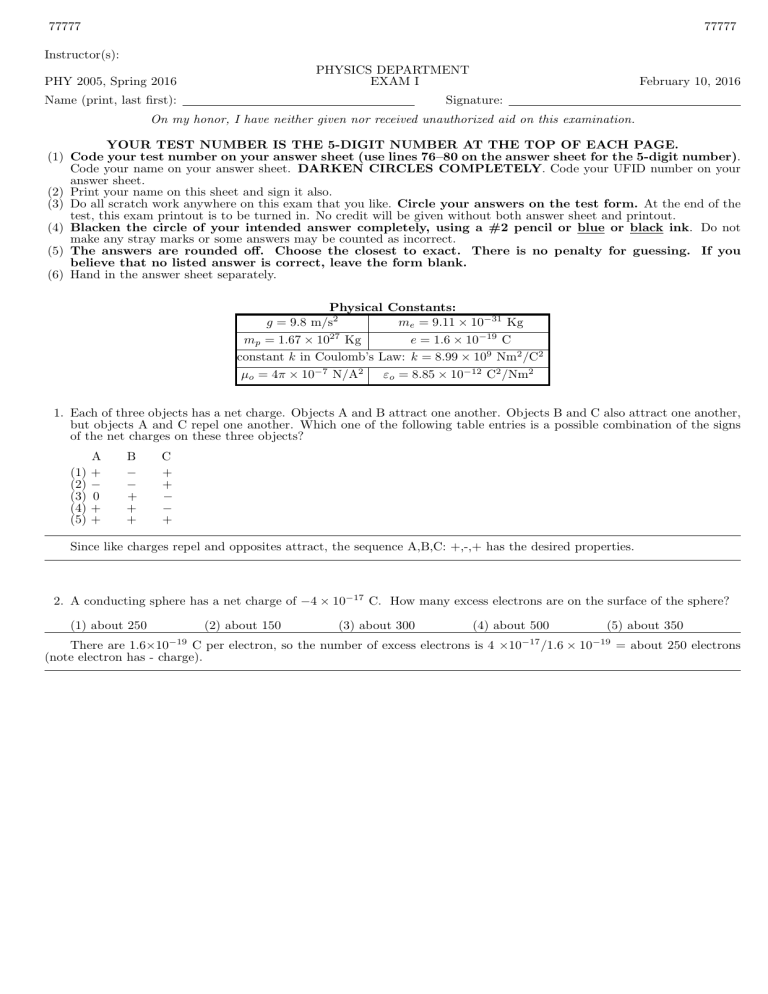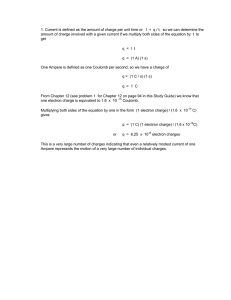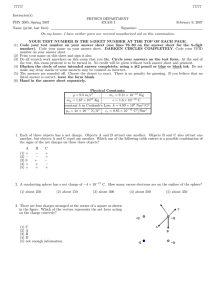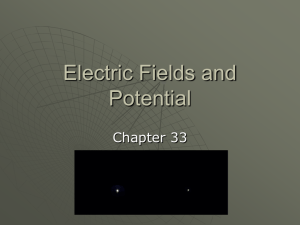Exam 1 with Solutions - Department of Physics

77777 77777
Instructor(s):
PHY 2005, Spring 2016
Name (print, last first):
PHYSICS DEPARTMENT
EXAM I
Signature:
On my honor, I have neither given nor received unauthorized aid on this examination.
February 10, 2016
YOUR TEST NUMBER IS THE 5-DIGIT NUMBER AT THE TOP OF EACH PAGE.
(1) Code your test number on your answer sheet (use lines 76–80 on the answer sheet for the 5-digit number) .
Code your name on your answer sheet.
DARKEN CIRCLES COMPLETELY . Code your UFID number on your answer sheet.
(2) Print your name on this sheet and sign it also.
(3) Do all scratch work anywhere on this exam that you like.
Circle your answers on the test form.
At the end of the test, this exam printout is to be turned in. No credit will be given without both answer sheet and printout.
(4) Blacken the circle of your intended answer completely, using a #2 pencil or blue or black ink . Do not make any stray marks or some answers may be counted as incorrect.
(5) The answers are rounded off. Choose the closest to exact. There is no penalty for guessing. If you believe that no listed answer is correct, leave the form blank.
(6) Hand in the answer sheet separately.
m p g = 9 .
8 m/s
Physical Constants:
2 m e
= 9 .
11
×
10
−
31
= 1 .
67
×
10 27 Kg e = 1 .
6
×
10
−
19
Kg
C constant k in Coulomb’s Law: k = 8 .
99
×
10 9
µ o
= 4 π
×
10
−
7 N/A 2 ε o
= 8 .
85
×
10
−
12 C
Nm
2
2 /C
/Nm 2
2
1. Each of three objects has a net charge. Objects A and B attract one another. Objects B and C also attract one another, but objects A and C repel one another. Which one of the following table entries is a possible combination of the signs of the net charges on these three objects?
A
(1) +
(2)
−
(3) 0
(4) +
(5) +
B
−
−
+
+
+
C
+
+
−
−
+
Since like charges repel and opposites attract, the sequence A,B,C: +,-,+ has the desired properties.
2. A conducting sphere has a net charge of
−
4
×
10
−
17 C. How many excess electrons are on the surface of the sphere?
(1) about 250 (2) about 150 (3) about 300 (4) about 500 (5) about 350
There are 1.6
×
10
−
19 C per electron, so the number of excess electrons is 4
(note electron has - charge).
×
10
−
17 / 1 .
6
×
10
−
19 = about 250 electrons
77777
3. There are four charges arranged at the corner of a square as shown in the figure. Which of the vectors represents the net force acting on the charge in the upper right correctly?
77777
(1) C
(2) A
(3) B
(4) D
(5) not enough information.
equal magnitudes. The hypotenuse of the triangle of forces from these two is then
√
2 F , where F = kQ 2 /a 2 , and a is the kQ 2 / (
√ a ) 2 = F/ 2. So the plus charges win due to the fact that they are closer, and the net force is at 45
◦ and to the right.
to the x -axis, up
4. Two small identical metal spheres carry charges of +1 .
3 µ C and
−
0 .
5 µ C and are 5.0 m apart. Now the spheres are touched together and again separated to 5.0 m. What force does one exert on the other? (in N)
(1) repulsive 5 .
75 × 10
−
5
(2) attractive 2 .
34
×
10
− 4
(3) repulsive 2 .
86
×
10
−
4
(4) attractive 8 .
25
×
10
− 4
(5) attractive 1 .
24
×
10
−
5
When the two identical conducting spheres touch, charge is equally distributed over both. Since charge is conserved, each sphere gets 0.4C for a total of 0.8C. Since they are separated by 5m at the end, the force between them is repulsive and equal to F = kQ 2 / (5 m ) 2 =5.75
×
10
−
5 N (here Q = 0 .
4C).
5. An electron with unknown kinetic energy is moving in an electric field. It slows down and is eventually brought to rest, after passing through a potential difference of 80 V. What was its initial kinetic energy? (in Joules)
(1) 1 .
3 × 10
−
17 (2) 4 .
8 × 10
−
18 (3) 60 (4) 0 (5) 30
In this problem, the initial kinetic energy of the particle is transformed entirely into electrostatic potential energy by moving the particle in direction of the field, i.e. “uphill” for a negatively charged particle. The potential energy change is the potential difference 80N/C, and the electron charge is -1.6
×
10
−
19 , so the potential energy is increased by 128
×
10
−
19 J or 1.28
× 10
−
17 J.
6. A hydrogen atom is composed of a nucleus containing a single proton (+e), about which a single electron (-e) orbits.
Let’s assume that the electron is making a uniform circular motion with a radius 5 .
3
×
10
−
11 m. What is the speed of the electron orbiting? (in m/s)
(1) 2 .
18
×
10
6
(2) 7 .
19
×
10
6
(3) 3 .
10
×
10
8
(4) 1 .
56
×
10
4
(5) 4 .
20
×
10
4
This was probably the hardest problem on the test, because you had to combine your knowledge of Coulomb’s law with something you remembered from mechanics. If an object is going in a circle, the magnitude of the force acting on it is the centripetal force , i.e.
F = mv 2 /R , regardless of what causes the force. In our case the force of attraction between electron and proton is electrostatic, so that mv 2 ke 2
F = = ,
R R 2 so v =
√ ke 2 /mR =
√
(9 × 10 9 )(1 .
6 × 10
−
19
(9 .
1
×
10
−
31 )(5 .
3
×
10
) 2
−
11 )
= 2 .
18
×
10
6 m/s.
77777
7. Two particles of the same mass carry charges +2Q and
–Q, respectively. They are shot into a region that contains a uniform electric field as shown. The particles have the same initial velocities in the positive x direction. The lines, numbered 1 through 5, indicate possible paths for the particles. If the electric field points in the negative y direction, what will be the resulting paths for these particles?
(1) path 5 for +2Q and path 2 for –Q
(2) path 4 for +2Q and path 2 for –Q
(3) path 1 for +2Q and path 4 for –Q
(4) path 2 for +2Q and path 4 for –Q
(5) path 3 for both charges
77777
The electric field in the down direction will exert a downward force on +charges, so they will curve downwards, and an upwards force on negative charges, so they will curve upwards. Since the +2Q is larger than the -Q, the downward curving particle will experience more force and therefore curve more, so paths 5 and 2 are best choices for +2Q and -Q, respectively.
8. A 5-A current is maintained in a simple loop circuit with a total resistance of 200 Ω. What net charge passes through any point in the circuit during a 1-minute interval? (in C)
(1) 300 (2) 1000 (3) 60000 (4) 12000 (5) 157
This just involves the definition of electric current: how much charge passes a given point per time. 1 Amp is 1C/s, so a 5 Amp current in a minute corresponds to 5 C/s
·
60 s =300C. The resistance given is irrelevant.
9. Reduce the resistors between A and B into a single equivalent resistor. (in Ω)
(1) 6.8
(2) 14.0
(3) 9.7
(4) 11.2
(5) 16.0
The 4Ω and 2Ω resistors in parallel give an equivalent 1.3Ω resistance by the parallel resistors formula 1 /R = 1 /R
1
+1 /R
2
The next parallel pair of 3 Ω resistors reduces to 1.5 Ω. Then you are left with three resistors in series that add, R =
.
R
1
+ R
2
+ R
3
, or 1.5 + 1.3 +4.0 Ω, or 6.8 Ω.
10. Using Kirchoff’s rules for junctions and loops, the following equations are set to solve the circuit shown in the figure. Choose one equation which describes the circuit incorrectly .
(1) 7 I
2
+ 6 I
1
= 9 (2) 7 I
2
+ 10 I
3
= 6 (3) 6 I
1
+ 10 I
3
= 3 (4) 7 I
2
−
6 I
1
= 3 (5) I
1
+ I
2
= I
3
This just involves writing down Kirchoff’s laws. There are 3 loop equations and 1 node equation, and they correspond to answers (2)-(5), so (1) is wrong (therefore the correct choice). An easy way to see that (1) is wrong is to notice that all loops involve only 1 battery, so the voltage that occurs in any loop equation must be 3V or 6V, but (1) has 9V.
77777
11. Two identical light bulbs (A and B) are connected as shown in the figure. Each light bulb produces 14.4 W of power. What is the resistance of the bulb? (in Ω)
77777
(1) 10 (2) 14.4
(3) 57.6
(4) 1.2
(5) 144
The two batteries push current in the same direction, for a total voltage of 24V. The light bulbs are identical, so they have resistance 2R. Hence by Ohm’s law the current that flows through each of them is I=24/2 =12A. The power dissipated in each bulb is P = I
2
/R = 12
2
/R = 14 .
4 W, so R = 10.
12.
A uniform electric field is set between two conducting plates as shown in the figure. An electron and a proton are released from their initial positions as indicated in the figure. Which of the following statements are wrong ?
(1) B, C (2) A, B, C (3) D, E (4) A, C (5) C, D, E
(A) Both electron and proton will move toward the plate farthest away from their current positions.
This statement is correct. The proton is pushed down by the downward field, and the electron pushed up.
(B) Both electron and proton will move in the direction that the electric potential decreases.
This statement is incorrect. The electric potential is defined to decrease in the direction of the field. But the electron is moving in direction of increasing potential.
(C) During the motion, the potential energy of the electron will increase.
This statement is incorrect. Potential energy will always decrease if a charged particle of either sign is set free to move.
(D) During the motion, the potential energy of the proton will decrease.
This statement is correct, see previous answer.
(E) During the motion, the kinetic energy of the electron and proton will increase.
This statement is correct. Each particle speeds up under a net external force, so kinetic energy increases.





